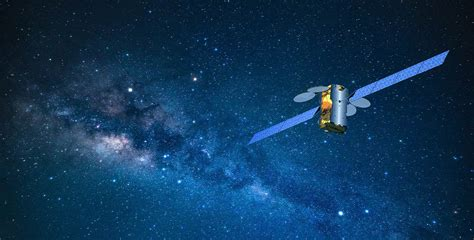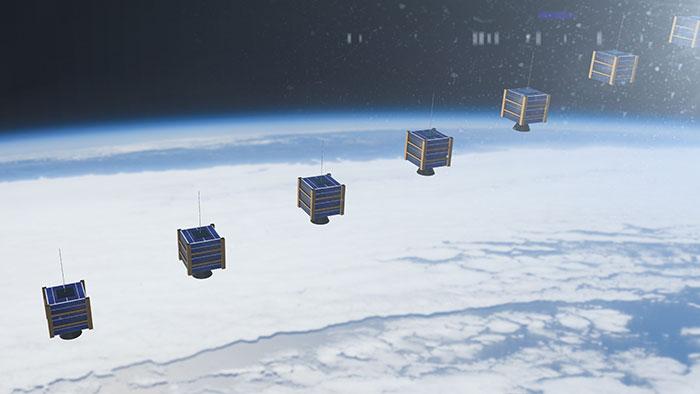
Refer to this table for more information about orbits Types of Orbits
1945 – Arthur C. Clarke’s Remarkable Prescience
The dawn of communications, the figure below demonstrates his idea. Even though, the technical aspect is not yet mentioned, but you can see his vision and his understanding of orbit satellites.

With 3 stations, it ensures the coverage of the entire globe.
1957 – USSR Launches Sputnik 1
History changed on October 4, 1957, when the Soviet Union successfully launched Sputnik I. The world’s first artificial satellite was about the size of a beach ball (58 cm.or 22.8 inches in diameter), weighed only 83.6 kg. or 183.9 pounds, and took about 98 minutes to orbit the Earth on its elliptical path. That launch ushered in new political, military, technological, and scientific developments. While the Sputnik launch was a single event, it marked the start of the space age and the U.S.-U.S.S.R space race.

Its only piece of equipment was a radio transmitter, which transmitted regular pulses on two different frequencies: 20 MHz and 40 MHz. Anybody with a short wave receiver tuned to either of these frequencies could pick up Sputnik’s signal as it passed overhead.
Sputnik 1 eventually settled into an elliptical orbit, which took the satellite as close to Earth’s surface as 142 miles (228 kilometers) and as far away as 588 miles (947 km). The satellite zipped around Earth every 96 minutes.
1962 – Skynet / NASA Launch Telstar 1
Telstar 1 was the pioneering satellite for transatlantic communications and facilitated the transmission of a television signal from Andover Earth Station in Maine to the Pleumeur-Bodou Telecom Center in Brittany, France. It operated using a low earth orbit (LEO) and was tracked by ground stations located in Maine and Brittany. Over a span of two years, Telstar 1 effectively transmitted more than 500 telegraph, telephone, facsimile, and television transmissions (source: NASA). Its successful operations demonstrated the feasibility of using satellites for communication purposes.

1964 – Summer Olympics is Televised Live via Satellite
A collaboration between NASA and the Japanese government saw a satellite, Syncom 3, previously intended for telephone use, upgraded to transmit TV signals. This made it possible to transmit live coverage of the games to over one-third of the globe (source: Olympics.com). Syncom 3 was the first satellite in geostationary orbit.

2003 – Eutelsat Launches e-BIRD, Designed for Internet Broadband
The first successful attempt to provide broadband satellite internet was in 2003, with the launch of Eutelsat Communication’s e-BIRD satellite. Using four ‘spot beams’ (the targeting of radio signals from the satellite to a specific point on Earth), this provided Europe with broadband and broadcast services in areas not served by ADSL and other terrestrial broadband technologies (source: Space Daily).
At the time of writing, and now renamed Eutelsat 31A, the e-BIRD is still in orbit, and still providing interactive broadband services.

How It Works in a Nutshell
- Launch and Deployment:
Eutelsat 31A was launched into a geostationary transfer orbit and then maneuvered into its final fixed orbit. This setup allows it to “hover” over a certain region of the Earth continuously. - Signal Uplink:
Ground stations send communication signals (data, TV signals, internet signals) to the satellite using a specified uplink frequency. - Onboard Processing:
The satellite’s transponders receive the uplinked signals, amplify and convert the frequency, and then redirect the signals. - Signal Downlink:
The processed signals are transmitted back down to Earth over a different frequency band. Receiving dishes or antennas on the ground pick up these signals to deliver the media or data service to end users. - Ongoing Management:
The operational center monitors all functions—ensuring stability in orbit, managing power resources, and fine-tuning communication parameters based on service needs.
2010-2011 – Eutelsat and ViaSat Launch High-Throughput Satellites
In December 2010, Eutelsat launched its KA-SAT satellite, which had 82 narrow spot beams connected to 10 ground stations across Europe, shortly followed by ViaSat’s ViaSat-1 in October 2010 with 72 spot beams, and ground stations across North America. This technology dramatically increased throughput, leveraging the high frequency Ka-Band (here’s the glossary by Ground Control if you’re not sure what that means); at the time, ViaSat-1 was the highest capacity satellite in the world.

 Both companies used ViaSat’s ‘Surfbeam’ technology for their ground network – the means by which data is passed from the ground stations to businesses and homes (sources: Eutelsat, ViaSat) – which played an important part in improving internet connectivity and speed.
Both companies used ViaSat’s ‘Surfbeam’ technology for their ground network – the means by which data is passed from the ground stations to businesses and homes (sources: Eutelsat, ViaSat) – which played an important part in improving internet connectivity and speed.
2014-2021 – Satellite Constellations Dramatically Increase the Number of In-Orbit Spacecraft
A satellite constellation is a system of interconnected low earth orbit (LEO) satellites that work collaboratively to establish a mesh network. Iridium was among the first to develop this technology, and it is currently experiencing a resurgence with the launch of new constellations such as SpaceX’s Starlink, Telesat’s Lightspeed, and Amazon’s Kuiper. Because constellations use many smaller satellites than the older (still entirely viable) geostationary satellites, where three or four satellites could cover most of the globe, this has seen an explosion in the number of spacecraft in orbit.
The value of LEO satellites is chiefly that because they’re closer to the ground, they can communicate with minimal time delay (low latency), so for voice applications they are particularly useful. They are also smaller, lighter, and less expensive than their geostationary counterparts (source: Science Direct), so the price of leveraging the service may be lower.
Adding to this is the growth in nano-satellite constellations.
What are nanosatellites
Nanosatellites usually weigh 1-10 kg (2.2-22 lbs), are quick to develop, and are less costly to build and launch than larger satellites (source: Alén Space). If a single nanosatellite is damaged at launch or by space debris, launching another to replace it is a much simpler exercise than rebuilding a medium or large satellite; indeed, most nanosatellites are not intended to last more than a few weeks, months or years before ceasing operations (source: Space.com).
One drawback of nanosatellites is that there is currently no dedicated means of getting them into space; they ‘piggyback’ on launches of much larger spacecraft, and so must wait for such an occurrence to take place. There are various companies looking at ways of making this easier, faster, and less expensive still.
Nanosatellites have the potential to dramatically increase the use of satellite connectivity for IoT and M2M applications; always attractive because of satellite’s reach into remote and challenging regions, the relatively low cost of a nanosatellite network means in turn, the cost of leveraging that network is low. This is a rapidly developing area and one we’ll be watching closely!
